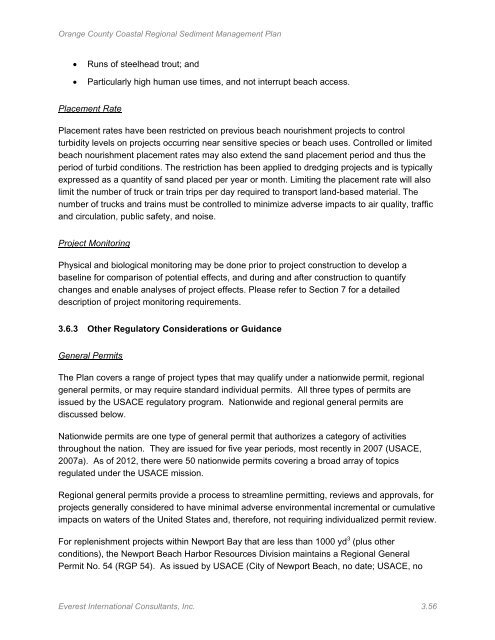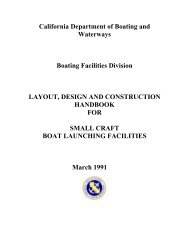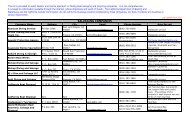EVEREST June, 2013 - California Department of Boating and ...
EVEREST June, 2013 - California Department of Boating and ...
EVEREST June, 2013 - California Department of Boating and ...
You also want an ePaper? Increase the reach of your titles
YUMPU automatically turns print PDFs into web optimized ePapers that Google loves.
Orange County Coastal Regional Sediment Management Plan<br />
• Runs <strong>of</strong> steelhead trout; <strong>and</strong><br />
• Particularly high human use times, <strong>and</strong> not interrupt beach access.<br />
Placement Rate<br />
Placement rates have been restricted on previous beach nourishment projects to control<br />
turbidity levels on projects occurring near sensitive species or beach uses. Controlled or limited<br />
beach nourishment placement rates may also extend the s<strong>and</strong> placement period <strong>and</strong> thus the<br />
period <strong>of</strong> turbid conditions. The restriction has been applied to dredging projects <strong>and</strong> is typically<br />
expressed as a quantity <strong>of</strong> s<strong>and</strong> placed per year or month. Limiting the placement rate will also<br />
limit the number <strong>of</strong> truck or train trips per day required to transport l<strong>and</strong>-based material. The<br />
number <strong>of</strong> trucks <strong>and</strong> trains must be controlled to minimize adverse impacts to air quality, traffic<br />
<strong>and</strong> circulation, public safety, <strong>and</strong> noise.<br />
Project Monitoring<br />
Physical <strong>and</strong> biological monitoring may be done prior to project construction to develop a<br />
baseline for comparison <strong>of</strong> potential effects, <strong>and</strong> during <strong>and</strong> after construction to quantify<br />
changes <strong>and</strong> enable analyses <strong>of</strong> project effects. Please refer to Section 7 for a detailed<br />
description <strong>of</strong> project monitoring requirements.<br />
3.6.3 Other Regulatory Considerations or Guidance<br />
General Permits<br />
The Plan covers a range <strong>of</strong> project types that may qualify under a nationwide permit, regional<br />
general permits, or may require st<strong>and</strong>ard individual permits. All three types <strong>of</strong> permits are<br />
issued by the USACE regulatory program. Nationwide <strong>and</strong> regional general permits are<br />
discussed below.<br />
Nationwide permits are one type <strong>of</strong> general permit that authorizes a category <strong>of</strong> activities<br />
throughout the nation. They are issued for five year periods, most recently in 2007 (USACE,<br />
2007a). As <strong>of</strong> 2012, there were 50 nationwide permits covering a broad array <strong>of</strong> topics<br />
regulated under the USACE mission.<br />
Regional general permits provide a process to streamline permitting, reviews <strong>and</strong> approvals, for<br />
projects generally considered to have minimal adverse environmental incremental or cumulative<br />
impacts on waters <strong>of</strong> the United States <strong>and</strong>, therefore, not requiring individualized permit review.<br />
For replenishment projects within Newport Bay that are less than 1000 yd 3 (plus other<br />
conditions), the Newport Beach Harbor Resources Division maintains a Regional General<br />
Permit No. 54 (RGP 54). As issued by USACE (City <strong>of</strong> Newport Beach, no date; USACE, no<br />
Everest International Consultants, Inc. 3.56




